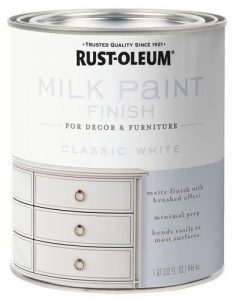Table of Contents
Introduction
Milk paint is an environmentally-friendly water-based paint that is sourced from 100% organic materials. The paint is non-toxic and biodegradable. Milk paint dries faster than oil paints. It dries within 30 minutes in contrast with 24 hours required for oil paints to get dried. Milk paints mostly exist in powder form; you only need to mix with water to form liquid paint.
The organic ingredients contact casein, which works as a binder; lime, which makes the paint durable and hard; and natural earth or mineral pigment, which gives it color. In some recipes, borax is combined with milk’s casein protein to activate the casein and act as a preservative.
The use of Milk Paint dates has been on for thousands of years. It dates back to cave drawings of 6,000 years ago. People used Milk paints because they come from household ingredients that were handy and tinted with organic earth pigments and natural substances.
Uses of Milk Paint
You can use Milk Paint on almost any surface, whether indoor and outdoor, without primer or sanding. The substances you can use Milk paint include glass, drywall, plaster, wood, and even metal. You can also use milk paint as a decorative finish for furniture, wood-working, and walls. You can use Milk Paint on artwork and even buildings. For instance, the Vatican City used traditional milk-based paint to finish the external walls of Belvedere Palace, a late 15th-century palazzo just north of St. Peter’s Square that houses treasured works of art. The process: Milk garnered from local cows was mixed with slaked lime and natural pigments to create the original cream color used in the 1500s and then hand-patted onto the walls.
Advantages of Milk Paint
Milk paint has some advantages, and they include:
- Milk paint is exceptionally durable, lasting for hundreds of years when you protect them from the elements.
- It is from natural ingredients.
- There are no synthetic binders in milk paint. Therefore, you can paint without leaving any brush strokes.
- With milk paint, you get a depth of color. Milk paint gives excellent dimension and visual interest.
- It adheres to virtually every clean and porous surfaces.
- It is non-flammable.
- It can be blended by the user to create many tints and shades.
- Its colors do not fade.
- It is fast drying.
- You can easily clean it up with water.
- It is solvent-free.
- It is not toxic to the environment.
Disadvantages of Milk Paint
- Milk paint does not come pre-mixed.
- Its cost is higher than the price of oil paints.
- After mixing the paint with water, you can only use it in less than a day, or more if it is refrigerated.
Painting panels can be a tad tricky!
The Best Way to Mix Milk Paint
There are several means to mix Milk paint. Milk paint can either be opaque concrete paint or a stain based on the amount of water added.
[LIST B](For solid opaque look: combine water and milk paint in the ratio of 1:1. Mixed milk paint should have the consistency of table cream for opaque coverage. When you are satisfied with the texture, use a little sample to see if you have gotten to the required thickness. The brush drags show that the mixture is opaque or too thick, and you need to add more water. If the paint is transparent and drips, you need to add more powder. You need to adjust as required and begin to paint.)
- For a stain/wash: Combine three parts of water to one aspect of Milk paint powder. Any color is useful for making a stain. Put water in the container first, add powder and steer with a spoon, whisk, an electric milk frother, or blender. You can use a blender for better results.
How to Apply Milk Paint
These are the steps you can take to apply milk paint:
- Mix: Measure about equal amounts of water and powder into separate containers. Mix them to get the consistency that you want. Note: warm water helps.
- Apply: Use a dry brush, spray gun, or roller. Natural bristle brushes are also good, but foam brushes may require less work and leave fewer brush marks. Milk paint is naturally somewhat streaky in color. It is normal. You can achieve the most even color by spraying. The second best option is the roller application.
- Clean-Up: Clean the tools with water and a Scotch-Brite pad to ensure that the color does not dry on them.
This post can help you with Techniques for the perfect paint job
Conclusion
If you are interested in an alternative paint that doesn’t negatively affect the environment, milk paint is the way to go.

